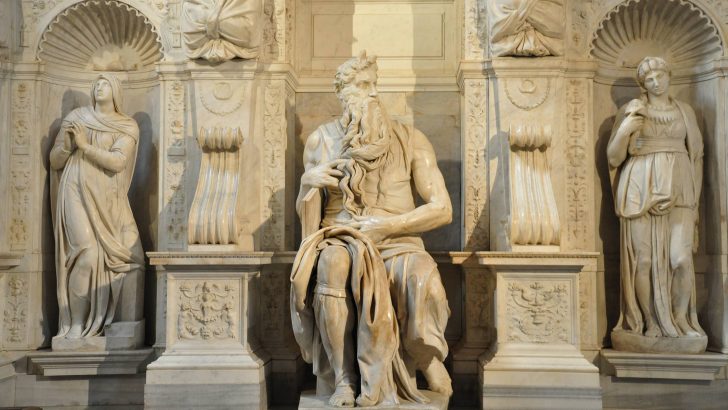Questions of Faith
There are plenty of religious artefacts, statues and artistic pieces which elicit intrigue, wonder and sometimes confusion. One object that fits into this category is the Moses – a sculpture by the famous Italian artist Michelangelo Buonarroti – which is housed in the church of San Pietro in Vincoli in Rome.
It was commissioned in 1505 by Pope Julius II, and peculiarly depicts the biblical figure with two horns on his head. It’s certainly an oddity, and has raised plenty of questions about why the artist chose to depict Moses in this fashion.
Is it true that the Bible describes Moses as having horns, and if not, where did Michelangelo find inspiration for this idea?
While there are plenty of different theories on this matter, there seems to be a general consensus that Michelangelo based the form of the sculpture on a biblical mistranslation in Exodus 34:29-30.
It reads: “As Moses came down from Mount Sinai with the two tablets of the covenant in his hands, he did not know that the skin of his face had become radiant while he spoke with the Lord.”
Description
The Hebrew word that is usually translated as ‘radiant’ or ‘shining’ (qaran) is closely associated with the word horns (qeren). So, when St Jerome was writing the Vulgate – the late 4th-Century Latin translation of the Bible – he chose to translate the description of Moses’ face as horned (cornuta). His wording led to subsequent literal interpretations by artists who believed that Moses had actual horns protruding from his face.
This translation, of course, wasn’t intended to imply that Moses had some connection with Satan who is also usually depicted with horns. Rather, in the ancient world, horns were seen as symbolic of power and authority, rather than an attribute that was negative or evil. It has been suggested, then, that St Jerome was trying to convey the point that Moses had been imbued with strength after his descent from Mount Sinai, not that he literally had horns.
“His wording led to subsequent literal interpretations by artists who believed that Moses had actual horns protruding from his face”
Others, however, have argued that he simply made a mistake, and unintentionally mistranslated the word. Indeed, this is a compelling argument given that the Septuagint – the Greek translation of the Hebrew Bible (from between 280-100BC) – refers to the face of Moses as “glorified”. This is echoed by St Paul who later writes: “Now if the ministry that brought death, which was engraved in letters on stone, came with glory, so that the Israelites could not look steadily at the face of Moses because of its glory” (2 Corinthians 3:7).
Regardless of St Jerome’s intentions, his translation created a long artistic and literary tradition of depicting Moses with horns. Throughout the world today, there are hundreds of horned Moses artworks based on this translational hiccup. Fortunately, now that you know the origins of the horned Moses, you can explain to others that Michelangelo didn’t’ think Moses was in colluding with the devil, but that the sculpture was probably based on a literary blunder.


 Colm Fitzpatrick
Colm Fitzpatrick Moses – a sculpture by the famous Italian artist Michelangelo Buonarroti. Phto Credit: Quarta Hospitality in Rome
Moses – a sculpture by the famous Italian artist Michelangelo Buonarroti. Phto Credit: Quarta Hospitality in Rome 
